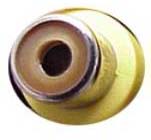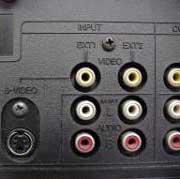|
 Connect
your TV: S-Video or RCA? Connect
your TV: S-Video or RCA?
The TV-Out
feature adds great benefits and flexibility to your PC. The ability to
view the computer’s display on a television gives the user the advantage
of more desktop space. The TV-Out feature on EVGA.com video cards may
either be selective or have the TwinView feature. TwinView offers the
option of having one computer monitor and one TV displaying video at the
same time. The selective feature, on the other hand, allows the use of
only one display at a time (computer monitor only or TV only).
Identifying
the Video Output Jacks
The video output jacks are located on the backside of the video card’s
mounting bracket. There will either be one or two types of video output
jacks depending on the EVGA.com TV Out video card that was purchased.
The first type of jack is a 4-pin female S-Video jack. An S-Video cable will be supplied with video cards
that have this jack. The second type of jack is commonly referred to as
an “RCA” video jack. The correct name is Composite Video female
output jack, and its yellow color is easily identified. Televisions that
do not have S-Video Input jacks may be connected to EVGA.com video cards
using a single Composite video cable. If you had purchased a video card
that only supports the S-Video feature but your television set only supports
a composite connection, an after market adapter can be purchased that
can convert the video signal from S-Video to Composite or vice versa.
These cables can be purchased at an electronics store or online at http://www.svideotorca.com.
 
S-Video on the left, Composite Video (RCA) on the right.
S-Video
Versus Composite Video Resolution:
Aside from the higher resolution that S-Video offers over Composite video,
there are other factors as to why an S-Video signal looks clearer than
a Composite video signal. S-Video is also known as Y/C video where the
Y represents luminance (black and white portion) and the C represents
chrominance (color portion). S-Video separates these two signals which
results in a higher picture quality. Composite video combines both the
luminance and chrominance into a single signal which must then be separated
by a comb filter inside the television. During this separation, certain
amounts of distortion and signal degradation occur.
|
TV
Connector
|
Resolution
Range (Horizontal Lines)
|
| S-Video |
400-420
|
| Composite
Video (RCA) |
200-220
|
Preparing
the Television for TV Out:
Be sure that your operating system is using the correct drivers
for your EVGA.com video card before connecting it to a television. You
can refer to our Install
Guides available under our Support
page for detailed step-by-step instructions on how to check if your
system is using the correct drivers as well as which version of drivers
you have currently installed. After confirming the preceding, you are
now ready to connect a television. The following are recommended steps:
- Shut
down your computer completely.
- Be
sure the television is powered off.
- Connect
either the S-Video cable or a Composite video cable to the back of
the mounting bracket of the video card. These jacks will be located
next to the DB15 jack for the computer monitor.
- Connect
the other end of the S-Video cable or the Composite video cable to
any available Video In/Video Input jack on the television.
- Turn
on your television and select the correct video input.
- Turn
on and boot-up the computer.

Avoiding
Possible Problems:
The maximum
display settings for televisions are 800x600, 32-bit color set at a refresh
rate of 60Hz.
Please Note: any display settings above these values may cause irreparable
damage to your television set!
When connecting
the video card to a television, it is highly recommended to go directly
to the TV and not through any type of intermediate devices. There is a
50% chance of successful video output when a VCR, RF Modulator, Receiver,
or any other similar device is being used.
For DVD
playback and the TwinView feature: Select Clone Mode under TwinView
options and use the Video Mirror Controls, found in the Overlay Controls
Panel, to adjust advanced settings. Click
here and download the Detonator Driver Release Notes (Adobe Acrobat,
PDF) for a complete guide on how to access Clone Mode, Overlay Controls,
and Video Mirror Controls.
|
 Connect
your TV: S-Video or RCA?
Connect
your TV: S-Video or RCA?

